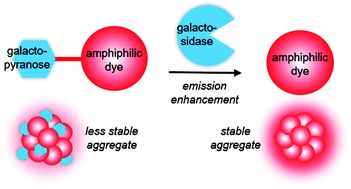Amphiphilic triphenylamine–benzothiadiazole dyes: preparation, fluorescence and aggregation behavior, and enzyme fluorescence detection†
Abstract
Fluorescence change systems that can respond to biological objects have attracted attention for use as biological probes and sensors. In this study, we report emission enhancement in a fluorescent aggregate composed of amphiphilic donor–acceptor dye molecules. The emission efficiency of the aggregate was reduced upon introducing a hydrophilic galactopyranose moiety, because of the decrease in the aggregate stability, which in turn was due to disruption of the hydrophilicity–hydrophobicity balance. In contrast, emission enhancement could be achieved by treatment with β-galactosidase, as a result of the removal of the galactopyranose moiety. The change in aggregate stabilization based on the hydrophilicity–hydrophobicity balance leads to the emission enhancement into detectable β-galactosidase activity.



 Please wait while we load your content...
Please wait while we load your content...